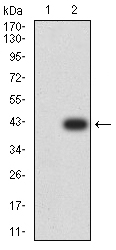Product Detail
Product NameAP2 beta Antibody
Clone No.G1-F7
Host SpeciesMouse
ClonalityMonoclonal
PurificationProA affinity purified
ApplicationsWB, FC
Species ReactivityHu
Immunogen DescRecombinant protein
ConjugateUnconjugated
Other NamesActivating enhancer binding protein 2 beta antibody
Activating enhancer-binding protein 2-beta antibody
AP 2B antibody
AP2 B antibody
AP2-beta antibody
AP2B antibody
AP2B_HUMAN antibody
AP2beta antibody
MGC21381 antibody
OTTHUMP00000039925 antibody
PDA2 antibody
TFAP 2B antibody
Tfap2b antibody
Transcription factor AP 2 beta antibody
Transcription factor AP-2-beta antibody
Transcription factor AP2 beta antibody
Accession NoSwiss-Prot#:Q92481
Uniprot
Q92481
Gene ID
7021;
Calculated MW50 kDa
Formulation1*TBS (pH7.4), 1%BSA, 40%Glycerol. Preservative: 0.05% Sodium Azide.
StorageStore at -20˚C
Application Details
WB: 1:500-1:2,000
FC: 1:100-1:200
Western blot analysis of AP2 beta on human AP2 beta recombinant protein using anti- AP2 beta antibody at 1/1,000 dilution.
Western blot analysis of AP2 beta on HEK293 (1) and AP2 beta -hIgGFc transfected HEK293 (2) cell lysate using anti- AP2 beta antibody at 1/1,000 dilution.
Western blot analysis of AP2 beta on ?SK-N-SH cell lysate using anti- AP2 beta antibody at 1/1,000 dilution.
Flow cytometric analysis of SK-N-SH cells with AP2 beta antibody at 1/100 dilution (green) compared with an unlabelled control (cells without incubation with primary antibody; red).
AP-2 transcription factor family members include AP-2α, AP-2β and AP-2γ, which specifically bind to the DNA consensus sequence CCCCAGGC and initiate transcription of selected genes. AP-2, also known as ERF-1, plays a role in regulating estrogen receptor expression. AP-2β, a splice variant of AP-2α, inhibits AP-2 activity. Besides subscribing to the AP-2 complex, AP-2α, AP-2β and AP-2γ proteins compose the OB2-1 transcription factor complex. OB2-1 specifically upregulates expression of the proto-oncogene c-ErbB-2, which is overexpressed in 25-30% of breast cancers. AP-2α may play an important role in the development of ectodermal-derived tissues. Deleterious mutations involving the AP-2α gene are linked to microphthalmia, corneal clouding and other anterior eye chamber defects. The ubiquitously expressed AP-4 transcription factor specifically binds to the DNA consensus sequence 5'-CAGCTG-3'. AP-4 interacts with promoters for immunoglobulin-κ gene families and simian virus 40. AP-4 may enhance the transcription of the human Huntington's disease gene. AP-4 is a helix-loop-helix protein that contains two distinctive leucine repeat elements.
If you have published an article using product 48426, please notify us so that we can cite your literature.






 Yes
Yes



